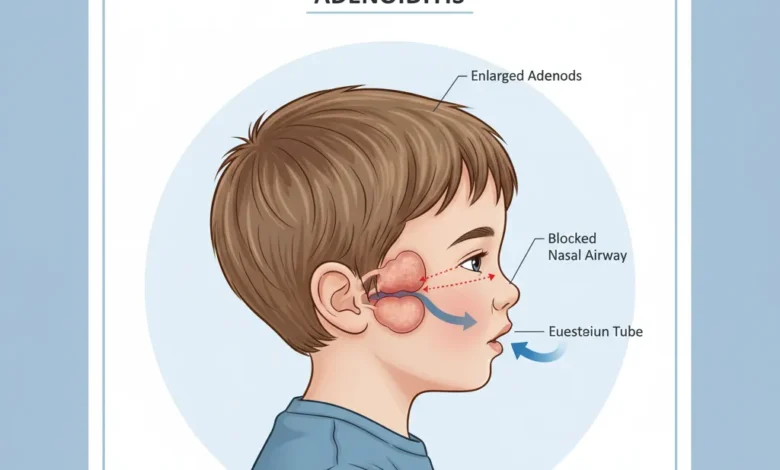Adenoidid: The Silent Condition That Can Affect Breathing

If you have ever caught your child snoring loudly, breathing through his mouth, or suffering from repeated ear infections, you might have assumed that it was just a seasonal cold or stubborn allergies. The problem, however, is often something less clear but far more bothersome-adenoidid. This refers to the inflammation or infection of the adenoids, tiny but very important glands at the back of the nasal passage. Adenoids, although small, are very important in the filtration of bacteria and viruses especially in children. When they become swollen or infected however, something as simple as breathing or sleeping comfortably can turn into a daily challenge. We will tell you everything you need to know about adenoidid: from the symptoms to causes, treatments, and recovery-all in the form of a conversation rather than a medical lecture.
Table of contents
- What Is Adenoidid?
- Symptoms of Adenoidid
- Causes Behind Adenoidid
- How Doctors Diagnose Adenoidid
- Treatment Options for Adenoidid
- When Adenoidid Is Left Untreated, What Are the Complications?
- Adenoidid in Children vs Adults
- Preventive Measures for Adenoidid
- Diet and Nutrition Lifestyle Changes for Supporting Recovery
- Conclusion
- FAQs
What Is Adenoidid?
Adenoidid results when adenoids-the first line of defense for the immune system in the newborns and children-are swollen due to infections, allergies, or irritation. They sit high in the throat, behind the nose and roof of the mouth. They are quite active in childhood, after which they start shrinking and may disappear altogether. Hence, adenoidid is much more common in kids than adults.
When the adenoids are swollen, they block airflow in the nasal passages. This makes breathing difficult especially at night, triggering a cascade of problems like poor sleep, ear infections, and chronic congestion.
Symptoms of Adenoidid
This is the only section to be formatted with bullet points, per your rules. The earlier the symptoms are detected, the faster and more effective treatment tends to be. Symptoms of adenoidid include:
- Persistent mouth breathing
- Loud snoring or noisy breathing during sleep
- Stuffy or blocked nose without a cold
- Recurring ear infections
- Difficulty swallowing or speaking clearly
- Bad breath despite good dental hygiene
If two or more of these symptoms occur frequently, it is well worth consulting a doctor to exclude adenoidid.
Causes Behind Adenoidid
Many things can cause this condition. In children, it is usually associated with either an infection or an allergy. Let’s break down the most common causes in plain language.
More often than not, the first is infection. Adenoids will swell when they are fighting against viruses or bacteria. A child who catches frequent colds or throat infections would be more likely to develop adenoidid.
The other causative agent is an allergic reaction. Dust, pollen, smoke, or pet dander irritates the adenoid tissue, promoting chronic swelling.
Another main origin of adenoidid is the superimposing chronic sinus infection. Given that the sinuses and adenoids are closely connected, an untreated sinus problem could potentially spread inflammation to the adenoids.
How Doctors Diagnose Adenoidid
Usually, the process begins with a simple history of symptoms. Parents would typically describe the snoring, mouth-breathing, or recurrent infections. The physical examination would then follow looking for evident signs.
In many cases, an endoscope, which is a thin and flexible tube with a small camera, permits visual inspection of the adenoids directly. This gives a good view of their size and condition.
In some cases, an X-ray or imaging scan may be done if the adenoids are not visible. Together with the medical history, these tests help in differentiating adenoidid from other conditions causing similar breathing and sleeping problems.
Treatment Options for Adenoidid
Not every case requires surgery. In fact, treatment depends on the severity of the condition. There are two major approaches.
Non-Surgical Treatment
Mild to moderate adenoidid is usually treated by medication and lifestyle modifications. Doctors may prescribe antibiotics only if evidence points toward bacteria. Anti-inflammatory medications and nasal sprays also serve to reduce the swelling. In case of allergy-related ones, treatment of the underlying allergy usually gives a quick relief.
Surgical Treatment (Adenoidectomy)
When symptoms become severe, recurrent, and unresponsive to medication, surgery becomes a consideration. An adenoidectomy-the surgical removal of the adenoids-is a fast and safe procedure generally done on young children. They recover fast, and all kids have subsequently shown improvement in breathing and sleep within no time prior to leaving the hospital after surgery.
When Adenoidid Is Left Untreated, What Are the Complications?
Left untreated, adenoidid could cause larger-than-expected problems. Restless sleep leads to fatigue and poor concentration during the day. Mouth breathing over time could alter the growth of a child’s face and narrow the upper-jaw area, combining with malpositioning of the teeth. Recurrent ear infections caused by enlarged adenoids could lead to temporary or even permanent hearing loss. Finally, if adults develop obstructive airway over time, they become potential candidates for sleep apnea.
You also like this: Soutaipasu Balance and Adaptation
Adenoidid in Children vs Adults
Children
Children are much more commonly afflicted with adenoidid because their adenoids are larger and active. Parents often notice symptoms like snoring, breathing difficulty at night, and repeated ear infections.
Adults
In adults, the condition is rare but not unheard of. When it does occur, it is typically associated with chronic sinus disease or recurrent infections. Surgery is often the treatment of choice because, in adulthood, the swollen adenoids are unlikely to shrink at all.
Preventive Measures for Adenoidid
One cannot completely escape adenoidid, but the risk can be minimized. The cleaner the hands, the less mucus, colds, or coughs irritating to the adenoids can trouble children. Keeping one’s home free from dust and allergens also limits the range of triggers. While parents should ensure that colds, sinus infections, and allergies are treated on time so that they do not bloom into adenoidid, it also helps to do periodic pediatric consultations so as to monitor the child’s overall wellbeing.
Diet and Nutrition Lifestyle Changes for Supporting Recovery
The role of nutrition in healing is very important. Foods loaded with vitamin C such as oranges, strawberries, and bell peppers can help in fighting infections and boosting one’s immune system. Adequate hydration also soothes the throat and clears off nasal passages.
Home Remedies
Using humidifiers in the bedroom would be wonderful since breathing will be easier with moist air. Gargling with warm salt water would help relieve irritation in the throat for older children and adults. Also, part of the treatment is that rest is essential in that the immune system repairs itself at night.
Medical Follow-Ups
Recovery does not end with symptom improvement. There would also be follow-up visits with ENT doctors to ensure it would not recur. If surgery were done, then the next follow-ups would determine healing and rule out complications.
Conclusion
Adenoidid may not sound like a big deal, but it affects breathing, sleep, and overall health. In children, it predominantly manifests in signs such as snoring, mouth breathing, and recurrent infection-never things parents should dismiss. The good news is that with timely diagnosis, treatment options are highly effective, either through medication or a simple surgical procedure. If you or your child is demonstrating constant signs of adenoidid, the best step is consulting with an ENT specialist. Early intervention restores better breathing and improves life quality for years to come.
FAQs
Q1: Is adenoidid an only-in-children ailment?
Nay. Although far more prevalent in children, some adults acquire adenoidid linked to their chronic sinus problems.
Q2: Can adenoidids heal on their own?
Mild cases sometimes clear spontaneously, mostly as the child grows older. However, recurrent or severe symptoms need medical treatment.
Q3: Does removal of the adenoids weaken the immune system?
Not at all. Adenoids become less important in immunity by the time they are surgically removed. Other lymph nodes take charge of the body’s defense functions.
Q4: How do I know if my child’s snoring is due to adenoidid?
If snoring is constant and accompanied by mouth breathing, frequent ear infections, messy sleep, then adenoidid should be checked.
Q5: What is the recovery from surgery like after adenoidectomy?
Most children recover within a week to a fortnight. Discomfort is mild and well controlled with pain relief. Breathing and sleep usually get better right away.





